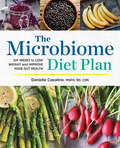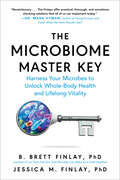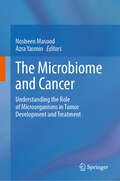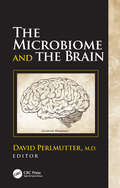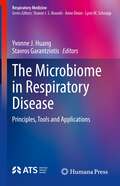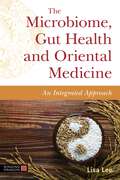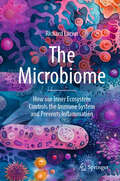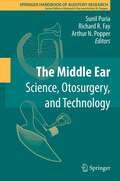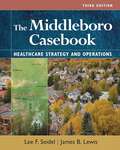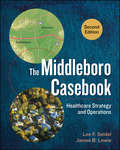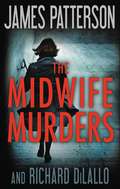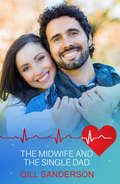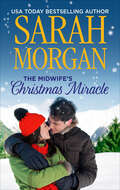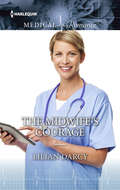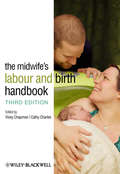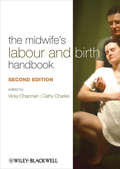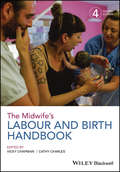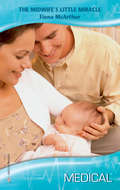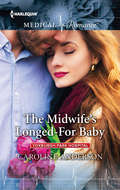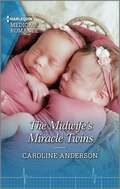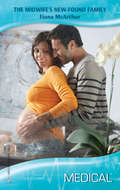- Table View
- List View
The Microbiome Diet Plan: Six Weeks to Lose Weight and Improve Your Gut Health
by Danielle Capalino MSPH, RD, CDNFeed your inner self to lose weight and feel great.Have you fed your microbiome today? The ecosystem of microbes in your gut affects your digestion, weight, energy level, and more. The Microbiome Diet Plan will help you nurture a healthy microbiome for a healthy life.You'll start by restoring your microbes to their happy place. Then, learn to sustain those positive changes for improved digestion, increased energy, and better sleep. This microbiome diet plan includes practical info like food charts, shopping lists, and lifestyle tips. Many of the recipes are grain-free, dairy-free, nut-free, or vegan.The Microbiome Diet Plan includes:Two-phase meal plan—Restore and sustain your gut health with a full 6-week microbiome diet meal plan.More than 125 recipes—Enjoy Sweet and Savory Orange Walnut Salad, Korean Beef Tacos with Red Slaw, Cinnamon Rice Pudding, and other tasty dishes.DIY fermentation—Make good-for-your-gut fermented creations like sauerkraut and kimchi, or even Fermented Salsa or Fermented Cranberry Sauce!Lose weight and find peace from the inside out with The Microbiome Diet Plan—your digestive system will thank you!
The Microbiome Master Key: Harness Your Microbes to Unlock Whole-Body Health and Lifelong Vitality (Second Edition)
by B. Brett Finlay Jessica M. FinlayLearn the secret to whole-body, lifelong health: the teeming world of microbes inside and all around you. Hand sanitizer. Social distancing. Antibiotics. Fending off germs has long been considered one of the cornerstones of good health. But what if better health and more graceful aging actually went hand-in-hand with embracing microbes? Your body is teeming with microbes—not just in the gut, but also on your skin, in your lungs, and beyond. And they impact everything from your sleep, cognition, mood, heart health, and energy to your likelihood of developing many diseases. As groundbreaking new studies are showing, taking care of your microbiome—inside and out—can help you improve your day-to-day health and even help prevent or reverse some of the most common age-related diseases. This eye-opening book breaks down what the latest research says about how the microbiome affects all aspects of physical and mental health—and what you can do about it. Potentially change the trajectory of 9 out of 10 leading causes of death, including heart disease, cancer, lung disease, stroke, Alzheimer’s disease, and diabetes Increase your resistance to pathogens like the flu and COVID-19 Keep your skin soft, healthy, supple, and less wrinkled Stabilize your weight and control blood sugar Improve your physical fitness and strength Fight “inflammaging”—low-grade inflammation that hastens the aging process Get a more restful and rejuvenating night’s sleep Reduce stress and improve mental health—and your long-term quality of life The Microbiome Master Key is an updated and expanded new edition of The Whole-Body Microbiome.
The Microbiome Solution
by Robynne ChutkanThe author of Gutbliss and one of today's preeminent gastroenterologists distills the latest research on the microbiome into a practical program for boosting overall health. Michael Pollan's widely discussed New York Times article, "Some of My Best Friends Are Germs," was just the tip of the iceberg. The microbiome--the collective name for the trillions of bacteria that live in our gut--is today's hottest medical news topic. Synthesizing the latest findings, Dr. Robynne Chutkan explains how the standard Western diet and lifestyle are starving our microbiome, depleting the "good bugs" that keep us healthy and encouraging overgrowth of exactly the wrong type of bacteria. The resulting imbalance makes us more prone to disease and obesity and negatively affects our metabolism, our hormones, our cravings, our immunity, and even our genes. But beyond the science, what sets this book apart is Dr. Chutkan's powerful three-level program for optimizing your gut bacteria for good health.Dr. Chutkan shares:Why hand-sanitizing gels and antibiotics are stripping our bodies of their natural protective systemsEssential prebiotics and probioticsRecipes with ingredients that replenish the microbiome for each rehab levelCutting-edge research on the connection between the microbiome and the brainAn intro to the stool transplant, the superfix for a severely troubled microbiome Dr. Chutkan is one of the most recognizable gastroenterologists working in America today, and this is the first book to distill the research into a practical, effective plan for replenishing our microbiomes. The Microbiome Solution will bring welcome relief to the millions who want to grow a good "gut garden"--and enjoy healthier, happier lives.
The Microbiome and Cancer: Understanding the Role of Microorganisms in Tumor Development and Treatment
by Nosheen Masood Azra YasminThis book explores the intricate relationship between microorganisms and cancer. It begins by discussing the microbiome of the human body and its role in cancer development. The cellular organization of tumors is also explored in detail. The book then delves into the specific microorganisms that have been associated with various types of cancer. The role of HCV in hepatocellular carcinoma is discussed in depth, as well as cancers associated with EBV. Further, it also explores the link between HPV and urogenital and head and neck cancers, and Kaposi’s sarcoma-associated Herpes virus. The chapter is dedicated to dispelling myths surrounding Aspergillus and lung cancer and examines the complications associated with fungal infections in cancer treatment. The book then explores the link between parasites and cancer, and the role that protists play in cancer development. Finally, the book concludes with a discussion of cancer management and therapies related to microorganisms. Overall, the book provides a comprehensive overview of the relationship between microorganisms and cancer and sheds light on how this relationship can be harnessed for more effective cancer management and treatment.
The Microbiome and the Brain
by David PerlmutterBrain related disorders are among the most challenging health issues of our time. The development of effective therapeutic and preventive strategies for these disorders relies on a comprehensive understanding of the underlying causative mechanisms. And, until recently, these mechanisms have remained somewhat elusive. The newly discovered pivotal role of the intestinal microbiome in brain health, functionality, and resistance to disease is revolutionizing neuroscience. The Microbiome and the Brain, through the contributions of some of the most forward thinking researchers and clinicians in the field, comprehensively reveals the leading edge of our understanding of the fundamental role of gut microbes and their metabolites in a wide array of seemingly diverse brain issues including Alzheimer’s disease, autism, multiple sclerosis, and mood disorders. In addition, mechanisms defining these relationships are explored along with a presentation of the state-of-the-art as it relates to interpretation of relevant laboratory assessments. Finally, novel therapeutic opportunities, derived from this exciting science are presented. Readers will learn: The highly validated relationship between alterations of gut microbes and their metabolites, and risk for Alzheimer’s disease. The important link between autism and intestinal dysbiosis. Appropriate interpretation of available laboratory assessments of the intestinal microbiome. The potential role of fecal microbial transplant in neurological diseases. The influence of diet and other lifestyle choices on the microbiome as it relates to brain health and functionality.
The Microbiome in Respiratory Disease: Principles, Tools and Applications (Respiratory Medicine)
by Yvonne J. Huang Stavros GarantziotisThis book comprehensively covers the microbiome in respiratory disease, from the initial research study to the disease-specific implications and related applications. Research on the respiratory microbiome is increasing in volume and scope. This reflects rapidly growing interest in the study of respiratory disease to understand how microbiota shape mechanisms of disease pathogenesis. The respiratory tract spans the nasal passages, sinus cavities, oropharynx, and the tracheobronchial tree of the lungs. In these compartments of the upper and lower respiratory tract, the microbiota have now been studied in the context of several chronic respiratory conditions. These include chronic sinusitis, allergic rhinitis, asthma, chronic obstructive pulmonary disease (COPD), bronchiectasis and pulmonary fibrosis, to name a few. The potential impact of ecological interactions (i.e., between microbes and between microbiota and host) within and across respiratory compartments is increasingly recognized.The book is organized into two main sections. Part I, Principles and Tools, covers conceptual modeling of the respiratory microbiome, experimental methodology with a focus on a priori considerations in study design and sampling, laboratory and computational methods for analysis of respiratory microbiome data, and minimizing interpretive pitfalls. Part II, Applications, discusses the evidence from specific studies that have shed novel insights into the influence of respiratory microbiota on mechanisms or outcomes in specific diseases. Based on current best evidence, disease-specific chapters include chronic rhinosinusitis, asthma (pediatric and adult studies), chronic obstructive pulmonary disease (COPD), cystic fibrosis (CF), bronchiectasis not due to CF, idiopathic pulmonary fibrosis, and lung transplant.This is an ideal reference for forward-thinking practitioners with interest in novel developments in precision medicine applications in lung disease, as well as translational scientists in the field of microbiology, immunology and lung biology.
The Microbiome in Rheumatic Diseases and Infection
by Gaafar Ragab T. Prescott Atkinson Matthew L. StollThis book discusses the role of the microbiome in rheumatic diseases and details its implications for patient treatment. Recently, with technological advances, there has been significant research into the microbiome. This has enabled us to more profoundly understand its role in our immune system maturation as well as the role played by microorganisms in autoimmunity and the deeply related rheumatic diseases. This book comprehensively explains the emerging microbiome research through the interrelationships of biomedical sciences, including: immunology, microbiology, bioinformatics, and, with special emphasis, the clinical aspect of rheumatology. It examines the interplay between infectious organisms and major autoimmune diseases, including rheumatoid arthritis, psoriatic arthritis, juvenile arthritis, systemic lupus erythematosus, and vasculitis, and explains how to apply that knowledge to diagnostic techniques and treatment decisions. The international team of expert authors provides insight into current therapies and future interventions specifically targeting the microbiota and explores the impact of our deeper understanding on enhancing personalized medicine. The Microbiome in Rheumatic Diseases and Infection is an essential resource for rheumatologists, pediatricians, internists, microbiologists, and critical care providers caring for children and adults with rheumatic diseases.
The Microbiome, Gut Health and Oriental Medicine: An Integrated Approach
by Lisa LeeThe human microbiome and its resident micro-organisms have in recent years come to represent a new frontier in health research and science. Yet this body of knowledge has hitherto been little addressed within Oriental Medicine theory and has consequently been underutilised in practice. The book proposes a novel and ground-breaking approach to understanding and influencing gut health and the microbiome by integrating the latest evidence from Western medical research and the long-established theory and practice of Oriental medicine. Building on an understanding of the body as a complete ecosystem where symbiotic relationships maintain balance in both mind and body, this integrative model sheds new light on an area that has seen rapidly growing interest both in and out of scientific communities, providing a more holistic and comprehensive perspective that both unites and broadens the potential applications of microbiome knowledge across medical and therapeutic traditions.The book's focus on the microbiome of the gastro-intestinal tract allows to explore the far-reaching and wide-ranging effects of the gut's micro-organisms on other body systems, on their ability to maintain good physical and mental health, and to fight disease and illness. This emphasis further provides readers with a practical guide to understanding and supporting a well-functioning gut and microbiome, through lifestyle choices and practices that focus on eating well, sleep hygiene, and mindful living.The booming interest in the area of gut health makes this compelling, accessible and informative hands-on book, an important tool for patients and practitioners of Oriental medicine and other relevant disciplines, offering readers a unique opportunity to add a new dimension to their knowledge of gut health. It will allow practitioners to deepen their professional development and enhance the quality of the care they provide by honing therapeutic skills and creating hybrid treatment plans that combine the latest findings from the gut-health literature and Oriental medicine.
The Microbiome: How our Inner Ecosystem Controls the Immune System and Prevents Inflammation
by Richard LuciusThis book unravels in an easily understandable way the exciting molecular connections between our gut microbiome, i.e. the collective microorganisms that we carry in our digestive system, nutrition and the immune system, and how an imbalance can lead to the development of inflammatory diseases. The totality of these gut microorganisms forms a complex ecosystem within us, consisting of hundreds of different species of bacteria. The author, microbiologist Professor Richard Lucius, introduces the historical context of microbiome research, discusses how our lives have changed in recent decades, and explains the composition and function of the microbiome and its connection to the gut and immune system. The book explains in detail and supported with appealing illustrations how allergies, chronic intestinal inflammation, type 1 diabetes, multiple sclerosis, rheumatoid arthritis, psoriasis and coeliac disease develop. Further chapters deal with the effects of nutrition on our intestinal flora and provide tips on building and maintaining a healthy microbiome. An intact bacterial community utilizes food residues that humans cannot digest and in return provides energy and vital substances. Only together with our inhabitants do we form a well-functioning "superorganism". Our immune system, which has developed over millions of years, is calibrated for a meagre, natural life. Under the influence of our modern way of life, the "Western lifestyle", our inner ecosystem is suffering from a loss of species, similar to our external environment. Highly processed foods, the influence of medication, lack of exercise and little contact with environmental bacteria are promoting this erosion process, which in the long term increases the risk of inflammatory diseases and obesity. As a result, more than 25% of people in modern societies suffer from allergies, autoimmune diseases and food intolerances that hardly existed in the past. This development can be counteracted by a healthy lifestyle that strengthens and diversifies the microbiome. This book is aimed at anyone who wants to understand the complex interplay between our gut microbiome, the immune system, nutrition and disease. The English translation of this volume, originally published in German language, was facilitated by artificial intelligence. A language editor has subsequently revised the text further in an endeavor to refine the work stylistically. The content was later revised by the author for accuracy.
The Middle Ear
by Arthur N. Popper Richard R. Fay Sunil PuriaThe middle ear plays a vital role in the sense and sensitivity of hearing. Of the various characteristics that distinguish mammals from other vertebrates, several pertain specifically to the middle-ear system, such as the presence of three middle-ear bones and the four-layer composite structure of the tympanic membrane. The Middle Ear attempts to elucidate the role this system plays in sound transmission, as viewed from both scientific and clinical perspectives.
The Middle Place
by Kelly CorriganThe Middle Place is memoir at its highest form. For Kelly Corrigan, family is everything. At thirty-six, she had a marriage that worked, two funny, active kids, and a weekly newspaper column. Then she went to the doctor...
The Middleboro Casebook: Healthcare Strategy And Operations
by Lee F. SeidelThe Middleboro Casebook: Healthcare Strategy and Operations is an integrated case study focused on the fictional community of Middleboro and the seven healthcare organizations that serve it, including two hospitals, a long-term care facility, a home health agency, two physician group practices, and a local health department. A thorough examination of Middleboro and its demographic, socioeconomic, political, epidemiological, and environmental data and characteristics enables students to analyze the community in detail, focusing on those factors that drive the need for and use of healthcare services as well as framing the strategic decisions made by healthcare organizations. Included in this book are eight cases that cover issues in each of the seven healthcare organizations, such as: <p><p> History<p><p> Governance<p><p> Organizational structure<p><p> Programs and services Finance<p><p> Operational challenges<p><p> Covering all areas of healthcare strategy and operations, this book can be used in a capstone course at the graduate or undergraduate level or it can be used across the curriculum in graduate programs in health administration, health policy, and public policy. This practical casebook integrates authentic management and policy issues into the classroom and bridges academic study and professional practice for students. Information presented in the cases will draw from material typically presented in multiple health administration courses to help students develop and refine their knowledge of healthcare strategy.
The Middleboro Casebook: Healthcare Strategy and Operations, Second Edition (AUPHA/HAP Book)
by Lee SeidelStudent Resources (click here for access) Instructor Resources: An extensive instructor’s manual that includes how-to guidelines and teaching notes, suggested assignments, and additional assignments that tie this book to the following Health Administration Press textbooks: Dunn and Haimann’s Healthcare Management, Tenth Edition Gapenski and Reiter’s Healthcare Finance: An Introduction to Accounting and Financial Management, Sixth Edition Gapenski’s Fundamentals of Healthcare Finance, Second Edition Olden’s Management of Healthcare Organizations: An Introduction, Second Edition Thomas’ Marketing Health Services, Third Edition Walston's Strategic Healthcare Management: Planning and Execution White and Griffith’s The Well Managed Healthcare Organization, Eighth Edition Zuckerman’s Healthcare Strategic Planning, Third Edition Give your students the opportunity to gain insight into the inner workings of a community and its healthcare providers. Students can practice and sharpen their managerial skills by applying what they learn to realistic scenarios. Instructors can use the cases in this book as a platform for helping students understand the interplay of factors that influence the development of healthcare strategy. Now in its second edition, The Middleboro Casebook offers a series of flexible, multipart, and integrated cases that bring to life eight healthcare organizations—two hospitals, a long-term care facility, a home health agency, two physician group practices, a community mental health center, and a county health department—in the fictional town of Middleboro and its surrounding communities. Created with today’s healthcare issues and realities in mind, each organization’s demographic, socioeconomic, and environmental characteristics are described in detail, including its: History Governance Organizational structure and strategies Programs and services Finance Operational challenges In this updated edition, all cases have been thoroughly revised to reflect changes in legislation, economic developments, and industry trends. All data have been updated or modified, and new organizational entities have been added, including a new case that portrays a community mental health center. The Middleboro Casebook can be used in undergraduate- and graduate-level health administration programs, as well as in business schools and public health or public administration programs. The book works equally well in capstone courses and multiple foundational courses, or as a recurring element woven throughout a program’s entire curriculum.
The Midwife Murders
by James Patterson Richard DiLalloIn this psychological thriller, a missing patient raises concerns in a New York hospital, but as others start disappearing every dark possibility becomes more and more likely. <P><P>To Senior Midwife Lucy Ryuan, pregnancy is not an unusual condition, it's her life's work. But when two kidnappings and a vicious stabbing happen on her watch in a university hospital in Manhattan, her focus abruptly changes. Something has to be done, and Lucy is fearless enough to try.Rumors begin to swirl, blaming everyone from the Russian Mafia to an underground adoption network. <P><P>The feisty single mom teams up with a skeptical NYPD detective to solve the case, but the truth is far more twisted than Lucy could ever have imagined. <P><P><b>A New York Times Bestseller</b>
The Midwife and the Single Dad: A Heartwarming Medical Romance (Medical Romances #18)
by Gill SandersonAnother captivating medical romance from best-selling author Gill Sanderson! Perfect for fans of Mia Faye, Laura Scott, Helen Scott Taylor, Grey's Anatomy and ER.Readers LOVE Gill's gripping medical romances!'Remarkable writer!!' 5* author review 'A truly wonderful writer' 5* author review 'I find all of Gill Sanderson's books very readable and enjoy the escapism they give me' 5* author review 'A truly gifted writer with an enormous amount of talent and sensitivity' 5* author review Fifteen years ago midwife and children's nurse Alice Muir had left her island home Soalay -and also her teenage sweetheart Ben Cavendish. Ben was now a doctor, Alice would be working for him. She wondered if coming back was a good idea. But she had to leave London. Her baby had miscarried and she had been unjustly accused of carelessness. She needed a refuge,Everywhere reminded her of past happy days with Ben. She fell in love with his small daughter, Fiona. But Ben had problems too. His divorce had been traumatic. Could he ever trust a woman again?Don't miss Gill Sanderson's enthralling medical romances, including the A Lakeland Practice and the Good, Bad and Ugly series.
The Midwife and the Single Dad: A Heartwarming Medical Romance (Medical Romances Ser.)
by Gill SandersonAnother captivating medical romance from best-selling author Gill Sanderson! Perfect for fans of Mia Faye, Laura Scott, Helen Scott Taylor, Grey's Anatomy and ER.Readers LOVE Gill's gripping medical romances!'Remarkable writer!!' 5* author review 'A truly wonderful writer' 5* author review 'I find all of Gill Sanderson's books very readable and enjoy the escapism they give me' 5* author review 'A truly gifted writer with an enormous amount of talent and sensitivity' 5* author review Fifteen years ago midwife and children's nurse Alice Muir had left her island home Soalay -and also her teenage sweetheart Ben Cavendish. Ben was now a doctor, Alice would be working for him. She wondered if coming back was a good idea. But she had to leave London. Her baby had miscarried and she had been unjustly accused of carelessness. She needed a refuge,Everywhere reminded her of past happy days with Ben. She fell in love with his small daughter, Fiona. But Ben had problems too. His divorce had been traumatic. Could he ever trust a woman again?Don't miss Gill Sanderson's enthralling medical romances, including the A Lakeland Practice and the Good, Bad and Ugly series.
The Midwife's Christmas Miracle (Lakeside Mountain Rescue #5)
by Sarah MorganA snowstorm traps a pregnant midwife with her sexy colleague for Christmas in this heart-warming romance by a USA Today–bestselling author.It was a miracle that he found her—freezing cold and alone in the treacherous snow-covered terrain of the English mountains. And with nowhere else to go, Miranda Harding finds herself agreeing to spend a magical Christmas Day with her rescuer.Gorgeous consultant Jake Blackwell doesn’t want to let this beautiful woman out of his sight, yet the next morning she’s gone. Only to reappear that same day as the new midwife in his OB-GYN department. That’s not the only surprise—it’s now startlingly obvious that his mysterious Miranda is also six months pregnant . . .
The Midwife's Courage
by Lilian DarcyA love that can overcome all the odds? Delivering babies all day while knowing she would never have one of her own was hard enough for midwife Katherine McConnell. Harder still, on her first date with gorgeous obstetrician Gian Di Luzio she discovered he wanted kids--and so she had to stop the affair before it even got started. Gian admired Kit's courage and selflessness in breaking off their relationship. But, working side by side with Kit, he realized that he wanted to be with her above all else. Surely that didn't mean he was falling in love...?
The Midwife's Labour and Birth Handbook
by Vicky Chapman Cathy CharlesPraise for previous editions: “An excellent resource for both student midwives and qualified staff alike.” (Alison James, Midwifery Lecturer, Plymouth University) "A lovely book with a lot of practical advice and easy to navigate. (Jayne Samples, Midwifery Lecturer, University of Huddersfield) This fully revised and updated third edition of The Midwife’s Labour and Birth Handbook is a practical and accessible guide to midwifery care. It addresses important questions such as: Why are women being pressured into caesarean section for breech presentation when the evidence is equivocal? If a baby needs assisted ventilation breaths at birth, why not bring the ambubag to the baby and leave the cord intact so the baby can benefit from the extra maternal oxygen supply? Why is skin-to-skin contact at birth so rarely offered to preterm babies when there is evidence of benefit? This well-regarded text promotes normality and woman-centred care, using research, evidence-based guidelines and anecdotal accounts from women. It challenges practice and guidelines which are biased or based on poor evidence. Guidance is offered on how to deal with difficult, sometimes controversial, situations. The Midwife's Labour and Birth Handbook 3rd edition is an essential guide for both student midwives and experienced practising midwives. New to this edition: Full colour photographs including a kneeling breech birth Suturing diagrams to assist left-handed midwives. Expanded chapters on slow progress in labour and malposition/malpresentations, including a rare photograph of a face presentation birth.
The Midwife's Labour and Birth Handbook
by Vicky Chapman Cathy CharlesTo practice effectively, midwives need to continually update their knowledge of pregnancy and birth. This fully revised and updated new edition of The Midwife's Labour and Birth Handbook is a practical and accessible guide to providing midwifery care while promoting 'women-centred' care and normality. It explores important questions such as: Why are women not encouraged to make a birth plan for elective CS? If a VBAC woman declines continuous CTG monitoring then why shouldn’t she use a waterbirth pool? If shoulder dystocia is anticipated, why not encourage all-fours birth in preference to a semi-recumbent position? Why are the needs of the delivering professional so often put before the advantages of upright postures for promoting descent of a second twin? This new edition incorporates the latest research and national guidelines, and includes new chapters on twins, caesarean section, bullying, risk management and IOL. By bringing together the latest midwifery information in a woman-centred way, The Midwife's Labour and Birth Handbook is an essential guide for both student midwives and experienced practising midwives.
The Midwife's Labour and Birth Handbook
by Vicky Chapman Cathy CharlesPraise for the previous edition: “…An outstanding handbook. It will be a familiar volume on most midwifery bookshelves, providing an excellent guide to midwifery focused care of both woman and child in the birthing setting.” - Nursing Times Online Providing a practical and comprehensive guide to midwifery care, The Midwife’s Labour and Birth Handbook continues to promote best practice and a safe, satisfying birthing experience with a focus on women-centred care. Covering all aspects of care during labour and birth, from obstetric emergencies to the practicalities of perineal repair (including left-hand suturing), the fourth edition has been fully revised and updated to include: Full colour photographs of kneeling extended breech and footling breech births New water birth and breech water birth photographs Female genital mutilation Sepsis Group B streptococcus Care of the woman with diabetes /Neonatal hypoglycaemia Mental health Seeding/microbirthing It also addresses important issues such as: Why are the numbers of UK women giving birth in stirrups RISING rather than falling? Why are so few preterm babies given bedside resuscitation with the cord intact? Would the creation of midwife breech practitioners/specialists enable more women to choose vaginal breech birth and is breech water birth safe? What is the legal position for women who choose to free birth – and their birth partners? Why are midwives challenging the OASI care bundle? Incorporating research, evidence and anecdotal observations, The Midwife’s Labour and Birth Handbook remains an essential resource for both student midwives and experienced practising midwives.
The Midwife's Little Miracle
by Fiona McarthurFinding she was pregnant was the best moment of midwife Montana's life. But days later she was widowed. Now nine months have passed, she has a tiny baby girl and is determined to make a fresh start. Dr. Andy Buchanan is impressed by Montana's courage, and he just can't get the beautiful new mom out of his mind. So he offers her a job at Lyrebird Lake--the perfect place to build a new life. Every time Montana sees her baby in Andy's arms, her resolve not to get involved crumbles a little bit more. He'd be the perfect father to her daughter, and she can't help but feel he'd be the perfect husband, too. . . .
The Midwife's Longed-For Baby
by Caroline AndersonA marriage worth fighting for Obstetrician Nick Jarvis and midwife Liv had the perfect marriage-until not conceiving the baby they ached for tore them apart. But separation has only compounded how much they need each other, and now they're working together again, delivering babies every day! It could be their chance to rekindle their relationship, but only if they can rediscover the sheer joy of loving-the one thing that will make their marriage whole and give them the courage to try for a baby again.
The Midwife's Miracle Twins
by Caroline AndersonSpecial delivery……for the midwife!Midwife Georgie loves her job. But the belief that she&’ll never hold a baby of her own makes her life on the maternity ward bittersweet. So, while the arrival of obstetrician Dan is a distraction Georgie isn&’t looking for…it&’s exactly the distraction she needs. After a difficult delivery, they find comfort in each other&’s arms. Yet just as they try to dial their relationship back to purely professional, Georgie discovers the incredible consequences of their night! &“An immensely talented writer who never fails to create likeable characters readers will instantly fall in love with, Tempted by the Single Mom is certainly no exception. A witty, poignant and heart-warming tale that will make readers smile….&”-Goodreads &“Overall, Ms. Anderson has delivered an emotionally-animating and entertaining read in this book where the main characters have strong chemistry; the romance was nicely-detailed….&”-Harlequin Junkie on From Heartache to Forever
The Midwife's New-Found Family
by Fiona McarthurWhen Misty saved the life of Dr. Ben Moore, she knew she would never forget the brooding single dad and the moment of tenderness they shared. So the midwife locked their brief encounter away in her daydreams and set off for a new life in Lyrebird Lake. She didn't expect to see his beautiful blue eyes ever again. Struggling to cope with his daughter alone, Ben has also moved to Lyrebird for a fresh start as the local doctor. In this magical setting, Misty and Ben rekindle that brief special moment--something they wish they could hold on to forever. Together, can they mend Ben's broken family, or is it too late?
